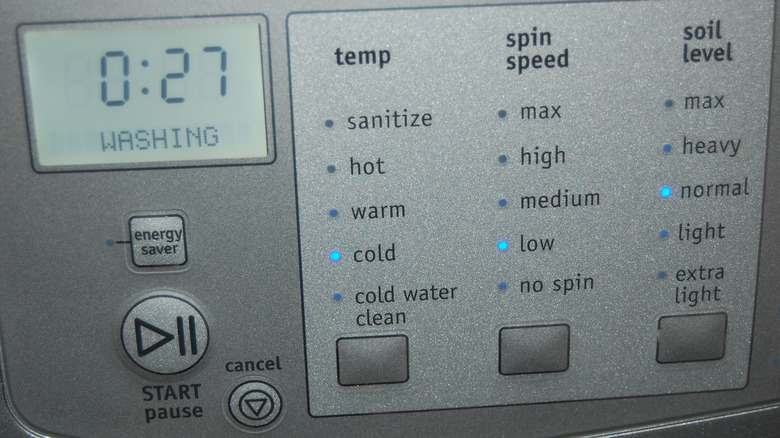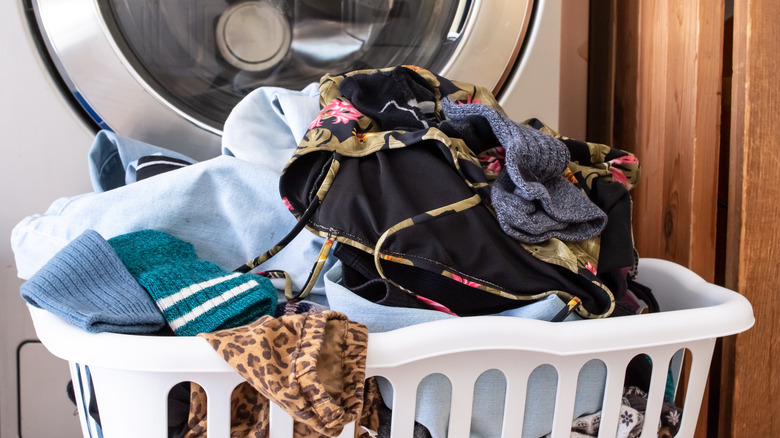What The Soil Level Setting On Your Washing Machine Really Means
They're called smart washing machines for a reason. All you need to do is push the right buttons in the correct order, and your clothes and linens come out the other side of the process perfectly washed. Here's the rub: there are so many functions, and knowing which to choose when can be overwhelming. Without a guide, you can probably find your way around more straightforward washing machine settings — like delicate versus regular wash or water level. When it comes to more obscure options — like, say, soil level — you need all the laundry machine settings explained. Here it is in a nutshell: Your washer's soil level setting adjusts the washing intensity based on how dirty your clothes are.
Most brands have some version of heavily, moderate, and lightly soiled to choose from when selecting the appropriate level. Still, the actual name of the label may differ between manufacturers and models. There are typically three options, but some machines have up to five, and the lowest setting is usually the default. For example, Maytag labels its soil level settings "heavy," "normal," and "light" across its top and front-loading washers. In contrast, some machines offer "extra light," "light," "normal," "heavy," and "extra heavy." Which you choose depends not just on how visibly dirty — or soiled — the clothes are; the heavier the fabric, the higher the soil level, even if the item is only a bit messy.
Why and how to use soil level settings
The soil level setting is optional on most machines, so why bother using it at all? Choosing a soil level setting often triggers other settings on the machine automatically. It's an easy, fast, energy- and resource-efficient way to get a wash tailored to a specific need — namely, getting clothes best cleaned based on how dirty they are.
Use the heaviest setting (or its equivalent) for well-used items, like pet beds, uniforms, thick blankets and comforters, and beach towels. If a garment is really smelly, wash it on the heaviest soil setting, even if you can't see any apparent stains. A moderate soil setting works great for jeans, t-shirts, fitness attire, and items stained with harder-to-get-out things like grass, blood, or brightly colored sauces. Choose a light setting for most everyday wear (think what you wear to the office) and undergarments, pantyhose, and clothing made from wool or nylon.
Testing by Consumer Reports found that the "normal" (or equivalent middle) option yields the best results in most cases and for most fabric items. Don't be afraid to experiment with different soil level settings based on your unique laundering needs. Pay attention to the results and adjust accordingly to achieve the best cleaning outcomes.
Soil level best practices
As you progress through each soil level setting, the duration, water temperature, agitation, and sometimes functions like water level increase. This affects everything from how much detergent you need to add to the machine to how full you load it. For example, a heavily soiled load may require double the detergent you need to clean a standard load. If in doubt about the butterfly effect your preferred soil level will have on the overall wash, consult the instruction manual that came with your model. Did you already throw that out, or do you have an old machine? Search for the manual online or request it from the manufacturer.
To get the most out of the soil level setting, sort washable items into piles based on how dirty they are. Instead of just whites and colors, split off the most soiled items to prevent contamination and ensure delicate items aren't subjected to heavy soil-level settings, which tend to be harsh. It's one thing everyone gets wrong when doing laundry. Other soil-level best practices include always choosing the lowest setting for your needs, shaking dust and dirt from clothing and even giving it a once-over with a lint roller before washing, and applying stain remover on stubborn spots.


